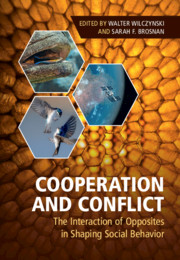Book contents
- Cooperation and Conflict
- Cooperation and Conflict
- Copyright page
- Dedication
- Contents
- Contributors
- Acknowledgments
- Introduction
- Part I Broad Insights from Political Science to Molecular Behavior
- Part II Neural Mechanisms
- 5 Social Living and Rethinking the Concept of “Prosociality”
- 6 The Role of the Temporal Lobe in Human Social Cognition
- 7 Role of Oxytocin and Vasopressin V1a Receptor Variation on Personality, Social Behavior, Social Cognition, and the Brain in Nonhuman Primates, with a Specific Emphasis on Chimpanzees
- Interim Summary
- Part III Species Comparisons
- Index
- References
6 - The Role of the Temporal Lobe in Human Social Cognition
from Part II - Neural Mechanisms
Published online by Cambridge University Press: 08 February 2021
- Cooperation and Conflict
- Cooperation and Conflict
- Copyright page
- Dedication
- Contents
- Contributors
- Acknowledgments
- Introduction
- Part I Broad Insights from Political Science to Molecular Behavior
- Part II Neural Mechanisms
- 5 Social Living and Rethinking the Concept of “Prosociality”
- 6 The Role of the Temporal Lobe in Human Social Cognition
- 7 Role of Oxytocin and Vasopressin V1a Receptor Variation on Personality, Social Behavior, Social Cognition, and the Brain in Nonhuman Primates, with a Specific Emphasis on Chimpanzees
- Interim Summary
- Part III Species Comparisons
- Index
- References
Summary
Humans exhibit an impressive array of social behaviors. We engage in complex cooperative behavior, employ flexibility in social responses, and navigate large social groups effectively. These behaviors are made possible by more fundamental cognitive abilities including facial recognition, communication, storing and accessing concepts about social entities, and processing emotions. All of these abilities have at least part of their neural basis in the temporal lobe (e.g., Deen et al., 2015), one of the major divisions of the cerebral cortex (see Box 6.1). The remarkable human facility for cooperation – and indeed, great conflict – suggests there may be equally remarkable features of the human brain.
- Type
- Chapter
- Information
- Cooperation and ConflictThe Interaction of Opposites in Shaping Social Behavior, pp. 104 - 133Publisher: Cambridge University PressPrint publication year: 2021
References
- 3
- Cited by

